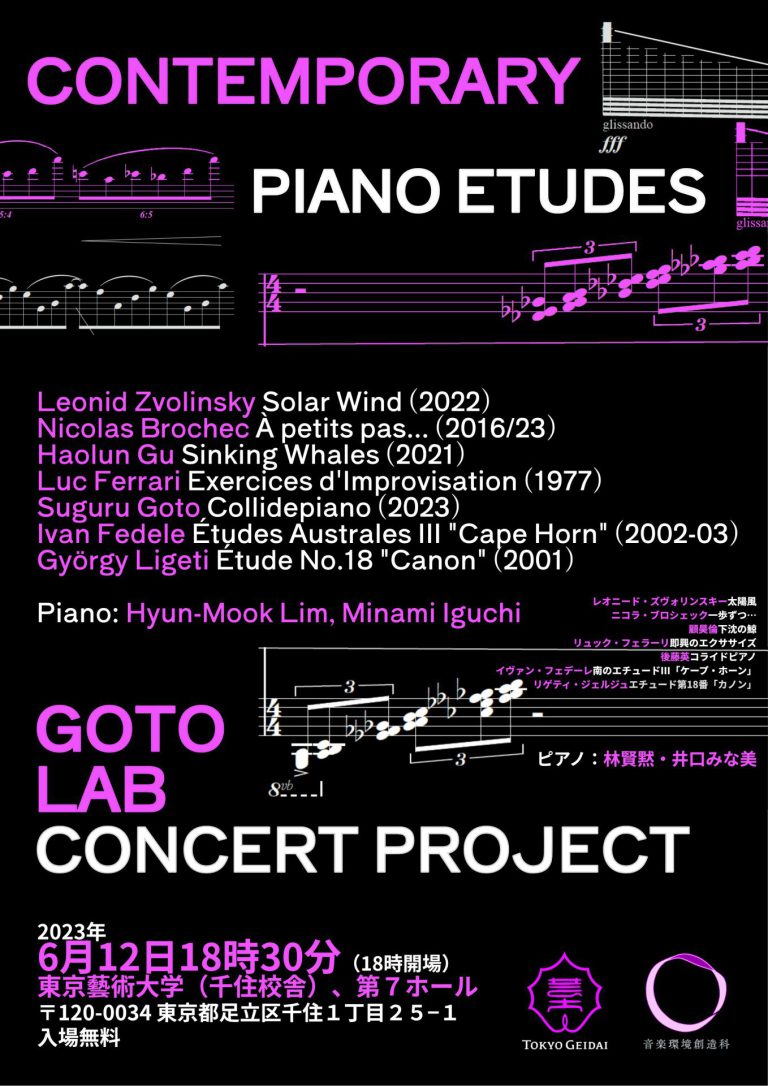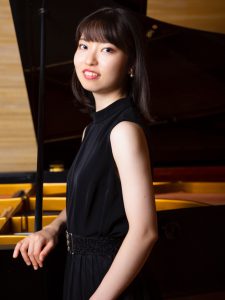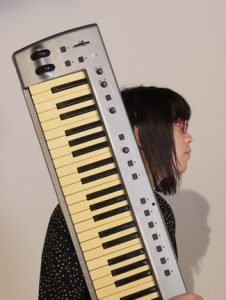Contemporary Piano Etude
Date: June 12, 2023 18:00 open, 18:30 start
Venue: Tokyo University of the Arts, Senju Campus, Hall 7
1-25-1 Senju, Adachi-ku, Tokyo 120-0034
Admission fee: Free

Program
1. “Solar Wind” - for Piano and Live Electornics / Leonid Zvolinsky (2022)
Piano: Hyun-Mook Lim
2. “À petits pas“ - for Piano and Live Electornics / Nicolas Brochec (2016/rev.2023)
Piano: Hyun-Mook Lim
3. “Sinking Whales” - for Piano and Live Electornics / Haolun Gu (2021)
Piano: Hyun-Mook Lim
4. “Études d'improvisation” NO. S 2 and 6 (or solely no. 2) - version for Piano and Live Electornics / Luc Ferrari (1977)
Piano: Hyun-Mook Lim
Intermission
5. “Collidepiano” - for Piano and Live Electornics / Suguru Goto(2023)
Piano: Minami Iguchi
6. Études Australes “Cape Horn” / Ivan Fedele (2002-2003)
Piano: Minami Iguchi
7. Piano Etude Vol.3 No.18 “Canon” / Gyorgy Ligeti (2001)
Piano: Minami Iguchi
Description of concert
Contemporary Piano Etude
The etude is a term primarily used to refer to short pieces written for the instrument intended to improve the technical ability of a performer. It is a musical piece for mastering the performance technique of an instrument, with the aim of improving the basic performance ability by mechanically repeating simple patterns.
The piano etude originates from Clementi. His etudes played a major role in the development of piano technique. Since Chopin’s groundbreaking piano works, composers began to give this form of composition the artistic value of etudes. Therefore, the technique of composing these short works also began to attract musical interest. Thanks to Chopin, the etude form was elevated from a mere technical study to a concert piece with an artistic quality. Composers such as Liszt, Scriabin, and Debussy basically followed Chopin’s form, although their composition languages were different. These are concert pieces that present different transcendental techniques for the piano. The compositional approach to the etude began in the twentieth century when the term “etude“ was considered as the study of composition. In the twentieth century, the etudes certainly present challenging techniques for pianists, but these are very different kinds from etudes in the nineteenth century. Stravinsky’s Etude op.7, written in 1908, explores polyrhythms, and Bartók focuses on chromatic scales and irregular time signatures in his Microcosmos.
In addition, the French word, “Étude”, which is the etymology of the word, means “study”. It is often used in fields other than music, as well. In the Fine Art field, it is used as a preliminary sketch for paintings and sculptures. It also means a theater play where one performs improvising.
Etudes written in the twentieth century include those related to traditional etudes and those requiring totally unconventional techniques.
Olivier Messiaen’s “Quatre études de rythme” (“Four Studies on Rhythm”, 1949-50) uses durations, scales, dynamics, forms, color and interval rather than didactic composition. We must also consider about the experiment. John Cage‘s Etude — Etude Australes for Piano (1974–75), Etudes Boreales for Cello and/or Piano (1978), Freeman Etude for Violin (1977–80, 1989–90) ) — are indeterminate works based on a star map. In the etudes by Ligeti (1985, 1988–94, 1995) each concentrates on a particular technique.
This “etude” is the theme of this concert. This indicates a contemporary meaning, which is a contemporary etude that explores compositional techniques. By systematizing experimental attempts at composing, it will also lead to the development of new composing techniques. Furthermore, new extensions of the piano are being attempted by using live(-)electronic technology. Live electronics here is not limited to the meaning of the past, but it can also be a pioneering new field of live electronics.
Biography of performers

Minami Iguchi
Minami Iguchi was born in Tokyo and started piano lessons at the age of four.
She graduated from Kunitachi College of Music, and completed the master’s course of ensemble pianist.
She won First Prize in the college student piano section of 17th Japan Music Performer’s Competition.
She won the 3rd prize in the 1st K Piano Solo Competition. She is a finalist of the contemporary music performance competition “Kyogaku XIV”.
She studied piano with Yoko Endo, Yukari Miyashita, Kazue Nakamura and Kayo Miki, and studied composition and composition theory under Hiroshi Yamaguchi, Takashi Fujii and Hisako Imamura.
She belongs to the contemporary music pianist group “Atelier de piano”.
She performs in a variety of music scenes as a soloist and an ensemble pianist.

Hyun-Mook Lim
Hyun-Mook Lim is a pianist and performance artist who specializes in new contemporary music in our age. She has worked with many composers in our times, and performed/premiered, even gotten a dedication of their works. She is recently residing in Tokyo, Japan and performing both in Japan and S. Korea. she is recently concentrating on expanding performance experience through music for Piano and fixed/live electronics.
Description of composition
“Solar Wind” - for Piano and Live Electornics / Leonid Zvolinsky (2022)
“Solar Wind” refers to the ionized plasma particles that are emitted at high temperatures from the sun and travel through space as a stream of charged particles known as “solar wind” between planets in the solar system. Solar wind can affect space weather and create various phenomena such as auroras. This composition reflects the distances between the planets and the sun through the rhythm and pitch of the piano part. The piano sounds consist of fragments of a series structure with different modes for each planet and ranges, while dwarf planets are distinguished by rhythm parts without a series structure. As the intervals between the sounds vary depending on the planet, the density of the planets in the solar system is expressed metaphorically in the music. The live electronics part involves real-time sampling, filtering, and spectral processing of the piano sounds.

Leonid Zvolinsky
Leonid Zvolinsky is a composer and sound artist currently based in Tokyo, Japan. He holds a degree in composition from the Moscow Conservatory, as well as degrees in music theory from Gnessins Musical College and sound engineering from the GITR Film & Television School in Moscow. Currently, he is pursuing a master’s degree in the Department of Musical Creativity and Environment at Tokyo University of the Arts, where he studies under the supervision of Suguru Goto and conducts research.
His works encompass electro-acoustic compositions and performances, various orchestral pieces, as well as solo and ensemble performances. Leonid employs Max, Arduino, and various algorithms and systems to explore the intersection of technology and sound. His research focuses on exploring the use of specific characteristics of hearing, such as sound illusions, in the creation of works of art.
“À petits pas” - for Piano and Live Electornics / Nicolas Brochec (2016)
À petits pas is a pedagogical mixed music piece, combining the possibilities of piano timbres with the dynamic versatility of electronic sound processing. With a total length of 6 minutes, the piece is designed to get young performers used to the cluster technique. It was first performed in 2016, but was revised for this concert.
In this composition, the piano explores and demonstrates the potential of clusters as musical blocks. The electronic part, on the other hand, serves as an immersive and interactive accompaniment, responding to and augmenting the piano performance in real-time.
The electronic sounds are carefully distributed through the quadriphonic sound system, enveloping the audience in a rich sonic environment that further enhances the experience of the piece. Realtime sound processing is employed, creating a dynamic counterpoint between the piano and the digitally processed sounds.

Nicolas Brochec
Nicolas Brochec is a French composer and software developer. He is currently a PhD student in the Department of Music and Sound Creation at Tokyo University of the Arts. His works have been performed at the Philharmonie de Paris (FR), as well as in Spain, Austria and elsewhere in Europe. He is often inspired by pictures and aims to create works that combine noise and pitch. His current research focuses on automatic instrument playing techniques recognition and dynamic sound processing in mixed music. His music works have been published by the music publisher Notes en Bulles.
“Sinking Whales” - for Piano and Live Electornics / Haolun Gu (2021)
“Imagination” is a primitive urge to explore the unknown sensory world, while music, as an abstract thing, probably has the most primitive features among them. However, in a “traditional” opinion, music usually depends on the temporal structure, and which is that structure guides listeners to understand the piece. But imagination is different. Depending on what we thought, what we heard, and even what we have seen, we could draw virtual landscapes or build enormous tales within our mind. Based on this idea, this piece fuses with the concept called “virtual theatre”, and shows the changing of “landscapes” through timbre differences and stage performance. This “non-progression-like” experience is just like a whale sinking into the deep ocean, and all the landscapes are floating around. Ocean currents, fish flocks, milky way, flickering light and shadows and floating sounds resonate with its huge body. Producing reverberation and echo, it drifts away.

Haolun Gu
A native of Soochow, China.
GU is a composer and pianist, received his Bachelor’s degree from Shanghai Conservatory of Music in 2017, and completed his Master degree in Tokyo University of the Arts in 2020. Now he is a PhD student in Tokyo University of the Arts. He has been awarded scholarship by the Japanese Ministry of Education, Culture, Sports, Science and Technology (MEXT) from 2021.
He received the 1st Prize at the 3rd Shanghai International Electronic Music Competition (IEMC) in Shanghai. His works have been commissioned and selected by The Centennial of the Electronic Musical Instruments at National Museum of Nature and Science (Tokyo), Future-Tradition New Media Masterclass Series (Shanghai), EMW (Shanghai), NYCEMF (New York), ICMC (Santiago de Chile) as well as Ensemble H[akka] 20th anniversary concert “Hiroshima and music” (Hiroshima), and got commission from the 7th Ryokoku Art Festival.
He has studied composition with Yi Qin, Mingwu Yin, Qiangbin Chen, Eric Arnal, Tatsuhiko Nishioka, and Suguru Goto.
“Études d'improvisation” / Luc Ferrari - version for Piano and Live Electornics (1977)
Exercises of Improvisaiton reflects the theatrical aspects of the composer. This work can be played by solo, or as an ensemble up to 8 performers. What is most important that the performers must get out from the clichés, and make a music with a huge freedom. With electronic drones weaved out by the speaker, the performers communicate each other with traversing the border of ordinary and extraordinary, verbal and non-verbal language, or even real and fiction. one could say that this is an extraordinary communication which is not observed in daily life, but rather within the realm of this composition. In today’s concert, this will be performed solo. But communication (or monologue) between a solo performer and a speaker could be shown as a total different experience from the communication between more than two actual people. Today No. s 2 and 6 are to be performed, but due to time loss only no. 2 may be realized.
Luc Ferrari
Luc Ferrari (February 5, 1929 – August 22, 2005) was a French composer of Italian heritage and a pioneer in musique concrète and electroacoustic music. He was a founding member of RTF‘s Groupe de Recherches Musicales (GRMC), working alongside composers such as Pierre Schaeffer and Pierre Henry.
“Collidepiano” - for Piano and Live Electornics / Suguru Goto(2023)
Section 1. Microtonal – Introduction (1:05)
Section 2. Microtonal 2 – Etude (3:08)
Section 3. Microtonal 3 – Glissando (1:56)
Section 4. Glissando 2 – Etude (2:00)
Section 5. Cell Division Algorithm – Etude (2:03)
Section 6. Ascending Morphing – Etude (3:00)
Section 7. Fast Repeated Notes – Etude (1:34)
This piece was inspired by Ligeti’s Piano Etudes (official name: Études pour piano).
The title, Collidepiano, is a coined word that combines Collide and Piano, and is a strategy in which a human pianist and a computer literally collide each other.
In this work, it was constructed with algorithmic composition by Bach library in Max.
The work is a suite, with each section built on one clear idea. The concept of each section is as follows:
Section 1. Microtonal – Introduction (1:05)
Rather than being a piece of music, it is an introductory part for accustoming the ear so that it becomes easier to distinguish microtones.
Section 2. Microtonal 2 – Etude (3:08)
The piece using microtones starts here in a real sense. An etude in which three voices are superimposed: one-eighth microtone, one-fourth microtone and normal tone.
Section 3. Microtonal 3 – Glissando (1:56)
This pursues glissando using microtones. It aims for a Shepard Tone-like effect.
Section 4. Glissando 2 – Etude (2:00)
A work that attempts glissando without using microtones. It is conceived to be as Etude of the second version of Section 3.
Section 5. Cell Division Algorithm – Etude (2:03)
As the title suggests, this work was created using a cell division algorithm. It could be considered to be a work composed by an algorithm rather than a composer’s intention.
Section 6. Ascending Morphing – Etude (3:00)
A piece that gradually changes throughout the piece, from one pattern to another.
Section 7. Fast Repeat – Etude (1:34)
It expresses a frenzied expression by playing the piano fast beyond the limit.

Suguru Goto
Suguru Goto is a composer/performer, an inventor and a multimedia artist and he is considered one of the most innovative and the mouthpiece of a new generation of Japanese artists. He is highly connected to technical experimentation in the artistic field and to the extension of the existing potentialities in the relation man-machine. In his works the new technologies mix up in interactive installations and experimental performances; he is the one who invented the so-called virtual music instruments, able to create an interface for the communication between human movements and the computer, where sound and video image are controlled by virtual music instruments in real-time through computers. Lately, he has been creating the robots, which perform acoustic instruments, and he is in process of constructing a robot orchestra.
He has been internationally active and has received numerous prizes and fellowships, such as Koussevitzky Prize, BSO fellowships, the first prize at the Marzena, Berliner Kompositionaufträge, a prize by the IMC International Rostrum of Composers in UNESCO, Paris, DIRECAM, French Cultural Minister, Music Theater Award 2008 in Berlin, “OFQJ-dance and new technology prize” at Bains Numérique #4, International Festival of digital art of Enghein-Les-Bains, in France, in 2009 and so on. His works have been performed in major festivals, such as Resonaces/IRCAM, Sonar, ICC, Haus der Kultures der Welt, ISEA, NIME, AV Festival, STRP Festival 2009, Venice Biennale, etc.
Études Australes “Cape Horn” / Ivan Fedele (2002-2003)
Études Australes, are lively and more virtuoso. Titles recall precise places (I, II e III) and two species of birds (IV e V). These are only metaphors for composition, more suggestions than advises. Also in this case, is again the region nearest to the Pole, if not the Pole itself, which is chosen in the hemisphere. Light is warmer here…
In Études Australes there is no indication of harmonic pedal. The use of this last is only suggested by the “harmonic” context and by the “character” of each Etudes and mostly, by the notion of “resonance”, not only psychological, that inhabits the entire work.
Études Australes consists of 5 pieces, and as the name suggests, the 1st, 2nd and 3rd pieces are named after places located on the Antarctic side, and the 4th and 5th piece are named after birds that inhabit that area. Compared to his work ” Étude Boréales” composed at the same time, there are many more technical pieces. The third piece “Cape Horn” will be performed among them this time.
Ivan Fedele
Ivan Fedele was born in Lecce in 1953. He studied piano with B. Canino, V. Vitale and I. Deckers, and composition under the guidance of R. Dionisi, A. Corghi and F. Donatoni. At the same time, he studied philosophy at the University of Milan, with E. Paci, L. Geymonat, R. Mangione and R. Cantoni. He owns to his father, a mathematician, the passion for mathematics, as it becomes evident in his compositional researches, including the examination and use of the concept of “spatialisation” (Duo en résonance, Ali di Cantor, Donacis Ambra), the formulation of a “library” of creative processes and the definition of a prototype of “granular synthesizer”, like the one used for the realization of the electronic part of Richiamo (for brass, percussions and electronics – IRCAM 1993). His piece Capt-Actions (for string quartet, accordion and electronics) uses for the first time a new system of “capteurs”, which are able to send all data regarding the contours of a musical gesture directly to the computer, which, in turn, interprets this information, on real time, according to the archetypes of modulation set a priori by the composer. Capt-Actions has been premiered at the Arsenale in Metz, in April 2005. This new technology, which has been developed by Thierry Coduys in the “Kitchen” studios of Paris, opens up new compositional perspectives, yet unexplored.
Piano Etude Vol.3 No.18 “Canon” / Gyorgy Ligeti (2001)
The collection of piano etudes consists of 18 pieces in 3 volumes and is packed with a lot of knowledge of the composer himself, such as painting, architecture(,) and mathematical elements.
The 18th piece of this volume 3, “Canon”, is a short canon played with both hands, first with vivace, then with presto impossibile, and finally closed with a quiet and gentle harmonic canon. This piece is dedicated to the pianist Fabienne Wyler.
Gyorgy Ligeti
Ligeti György (28 May 1923 – 12 June 2006) was a Hungarian-born Austrian composer of contemporary music.
He is a master of contemporary music who has fascinated people with his unique musical style, surpassing the limits of serialism that was the mainstream of avant-garde music after World War II.
He has left many experimental works, and his music has been used in movies and other media, and is widely known.